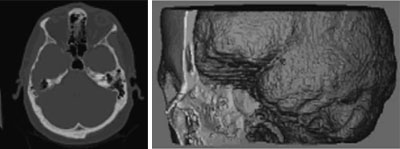Step 1
Pre-processing
Prior to building any structure, a blueprint must first be developed. A drawing of the structure is formulated through a computer-aided design (CAD) that provides the spatial information as to the precise location of all the cells. The information or digitized image data reconstruction needed to generate these blueprints or drawings can be obtained through a number of methods, all with their advantages and current limitations:
1. Recent advances in bioimaging and image acquisition techniques enable image capture that provides detailed representations of the gross anatomy of organs. Imaging modalities such as Magnetic Resonance Imaging (MRI) or Computerized Tomography (CT) scans offer a noninvasive approach to image capture. However, cellular level characteristic detail such as tissue composition and distribution cannot be captured at current resolution limits.

CT scan data (CT scan slice on left) can be used to generate a 3D model (right) of the skull and brain.
2. Alternatively, information from serial histological sections can be used to reconstruct or render 3D representations. This method provides information of the tissue composition and the size and shape of the organ. However, most technologies should avoid the need to sacrifice subjects or tissue sections in order to obtain information.
3. Mathematical and computational technologies in combination to one's knowledge of the human anatomy can lead to the development of accurate and detailed models through computer simulation.

The top images are mathematical models of the proposed cell aggregate behavior upon implantation in a 3D gel. The bottom two images show the resulting bioprinted disc-like structure as ten cell aggregates before (bottom left) and after fusion (bottom right). Notice the strong correlation of the printed structures to the model.
Ultimately, it would be ideal to integrate the bioimaging, image acquisition techniques and mathematical-computation-anatomical technologies towards developing a blueprint that accurately represents the natural tissue (anatomically, histologically etc.). Such a blueprint should also factor in dynamic events such as tissue fusion, compaction and retraction and constant remodeling.
TOP

